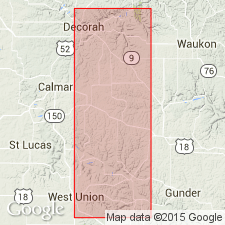
- Usage in publication:
-
- Glenwood shale
- Modifications:
-
- Original reference
- Dominant lithology:
-
- Shale
- AAPG geologic province:
-
- Iowa shelf
Summary:
Pg. 60, 61, 75. Glenwood shale. Shale, 3 to 15 feet thick in Glenwood Township [Winneshiek County, Iowa], lying between St. Peter sandstone below and Platteville limestone above, described as "Basal Shale" in earlier reports, and supposed to represent initial phase of Trenton series. In lower 8 to 10 feet it shows streaks and bands of sand, indicating close relationship with St. Peter sandstone. This lower part is assigned to St. Peter stage of Canadian series.
Source: US geologic names lexicon (USGS Bull. 896, p. 830-831).

- Usage in publication:
-
- Glenwood beds
- Glenwood shale
- Modifications:
-
- Overview
- AAPG geologic province:
-
- Iowa shelf
- Wisconsin arch
Summary:
The shaly beds forming basal part of Platteville limestone in some areas consist of transitional shales and limestones 7 to 110 feet thick, and are by most writers, including E.O. Ulrich, 1924, included in Platteville limestone; but A. Bevan (Illinois Geol. Survey Rpt. Inv., no. 9, 1926) advocated making them a distinct formation, under the name Glenwood beds; and Iowa Geol. Survey (v. 33, 1928, v. 34, 1929) not only treated them as a distinct formation but included them in Lower Ordovician. In Iowa Geol. Survey v. 33, p. 33-36, 1928, many well logs record a thin bed of limestone between Glenwood shale and underlying St. Peter sandstone, and record upper part of the Glenwood shale consisting of 0 to 15 feet of sandstone, and in southwest part of State report a thickness of 80 feet for the Glenwood.
Source: US geologic names lexicon (USGS Bull. 896, p. 830-831).
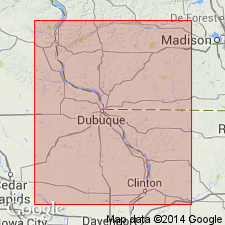
- Usage in publication:
-
- Glenwood shales
- Modifications:
-
- Overview
- AAPG geologic province:
-
- Wisconsin arch
- Iowa shelf
Summary:
Pg. 90. Glenwood shales. Merely a new name for what is long known as the top of Peter sandstone [St. Peter sandstone].
Source: US geologic names lexicon (USGS Bull. 896, p. 830-831).
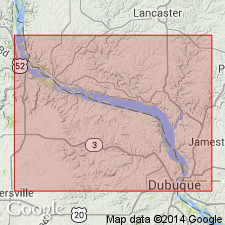
- Usage in publication:
-
- Glenwood member
- Glenwood shale
- Modifications:
-
- Revised
- AAPG geologic province:
-
- Wisconsin arch
- Iowa shelf
Summary:
Pg. 98-111. Glenwood member of Platteville limestone and Glenwood shale. Treated these beds as basal member of Platteville limestone, as did Kay (Rpt. 9th Ann. Field Conf. Kansas Geol. Soc., 1935, p. 285-288), and the "Conference classification," fig. 1; but according to fig. 2 of this Conference report the Iowa and Illinois Surveys exclude these beds from Platteville limestone. Kay stated Glenwood member is overlain by Pecatonica limestone. On p. 383-384 of this Conference report A. Bevan stated that near Oregon, Ogle County, northwestern Illinois, the Glenwood consists of 2.5 to 12 feet of glauconitic sandstone, which "in this paper is considered as a separate formation, rather than as a member of the Platteville." C.R. Stauffer, 1935 (Jour. Paleo., v. 9, no. 7, p. 597), also treated Glenwood as distinct formation.
Source: US geologic names lexicon (USGS Bull. 896, p. 830-831).
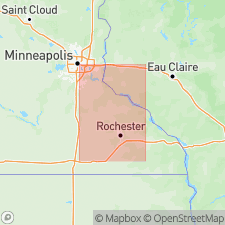
- Usage in publication:
-
- Glenwood beds
- Modifications:
-
- Biostratigraphic dating
- AAPG geologic province:
-
- Wisconsin arch
- Iowa shelf
Summary:
Glenwood beds. Described, discussed, and figured conodonts from these beds, which he stated (p. 130-131) are "filled with Middle Ordovician life and most of its fauna is of that age." Also that "the fossil-bearing Glenwood beds belong in the Mohawkian series, and are not much older than Platteville limestone."
Source: US geologic names lexicon (USGS Bull. 896, p. 830-831).
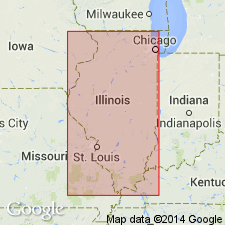
- Usage in publication:
-
- Glenwood subgroup [informal]
- Modifications:
-
- Revised
- AAPG geologic province:
-
- Wisconsin arch
Summary:
Pg. 11 (fig. 3). Glenwood subgroup [informal] of Ancell group. Shown on columnar section as Glenwood subgroup of Ancell group (new). Includes (ascending) Kingdom, Daysville, Loughridge, and Harmony Hill formations (all new). Age is Middle Ordovician.
["Subgroup" not recognized as a formal stratigraphic rank term (CSN, 1933; ACSN, 1961, 1970; NACSN, 1983, 2005, 2021). Considered informal and should not be capitalized.]
Source: US geologic names lexicon (USGS Bull. 1200, p. 1528-1529).
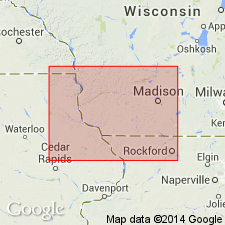
- Usage in publication:
-
- Glenwood shale member*
- Modifications:
-
- Principal reference
- AAPG geologic province:
-
- Wisconsin arch
- Iowa shelf
Summary:
Pg. 275-277. Glenwood shale member of Platteville formation. Further described as shale member of Platteville. Type locality stated.
Type locality: in sec. 6, T. 98 N., R. 7 W., Winneshiek Co., northeastern IA.
Source: US geologic names lexicon (USGS Bull. 1200, p. 1528-1529).
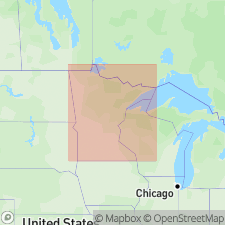
- Usage in publication:
-
- Glenwood formation
- Modifications:
-
- Revised
- AAPG geologic province:
-
- Iowa shelf
Summary:
Pg. 57, 58; M.P. Weiss, 1957, GSA Bull., v. 68, no. 8, p. 1030. Glenwood formation. Referred to as a formation overlying the St. Peter sandstone and underlying Platteville formation. Age is Middle Ordovician.
Source: US geologic names lexicon (USGS Bull. 1200, p. 1528-1529).
For more information, please contact Nancy Stamm, Geologic Names Committee Secretary.
Asterisk (*) indicates published by U.S. Geological Survey authors.
"No current usage" (†) implies that a name has been abandoned or has fallen into disuse. Former usage and, if known, replacement name given in parentheses ( ).
Slash (/) indicates name conflicts with nomenclatural guidelines (CSN, 1933; ACSN, 1961, 1970; NACSN, 1983, 2005, 2021). May be explained within brackets ([ ]).

